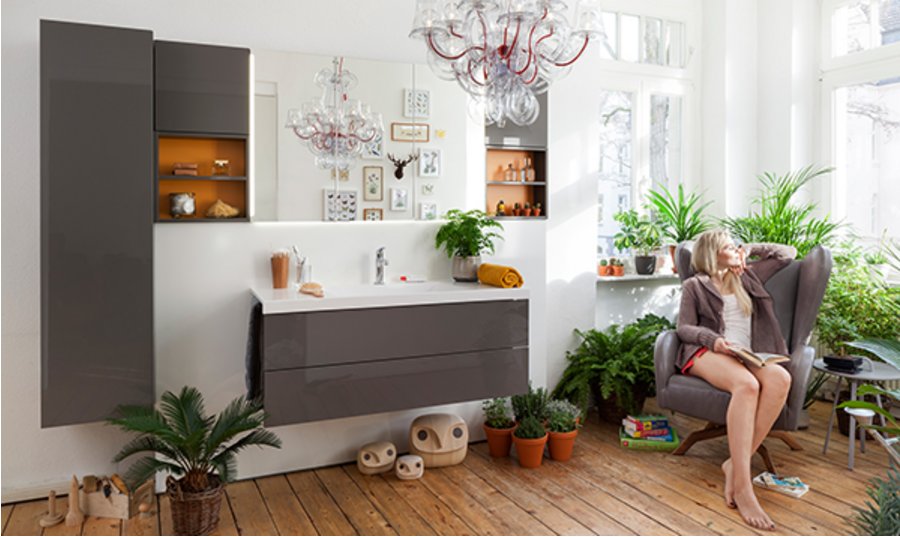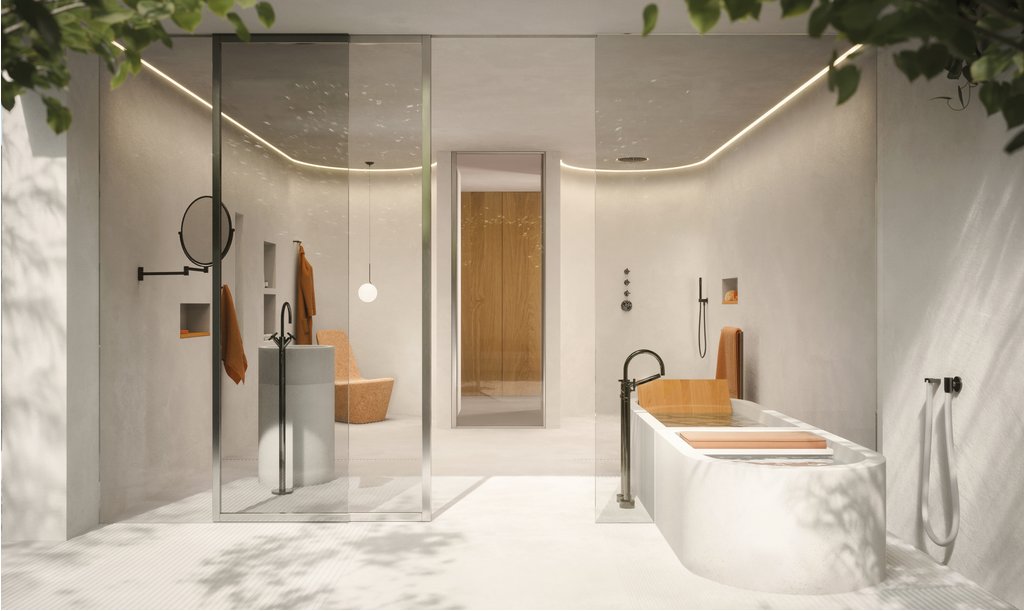Where this bathroom megatrend originates from is just as uncertain as it is irrelevant. Regardless of whether it stems from the desire for an aesthetic upgrade for the entire home, from the yearning for a place to retreat to away from once-private quarters that are increasingly being used for social and professional purposes, from increased health consciousness or simply from the desire to treat ourselves to a bit of luxury. Fact is that the bathroom is playing an ever more important role, both in terms of the architecture and how the home is furnished. But whilst bathroom design learned to stand on its own two feet by riding the minimalist wave of purist severity, thus managing to soothe the scepticism of conservative customers with an atmosphere of hygienic coolness, the last remaining inhibitions about turning the bathroom into living space once and for all are now falling away.
It starts with the flooring and tiles. Big slabs of natural stone or comparable materials feel good under bare feet – especially when combined with underfloor heating – and give the walls a warm, natural touch. Nowadays even natural wood flooring comes in plenty of water-resistant grades, and textiles aren't only present in the form of towels any more: they veil the daylight, cover seats and tempt us to stretch out and relax on deep-pile carpets. Nowadays, many things that were still frowned on as unhygienic just a few years ago have been made possible by the high-tech properties of modern textiles and artificial fibres that have been put through their paces by outdoor furniture.
As our inhibitions fall away, the walls are gradually disappearing with them. The walls to the neighbouring bedroom, balcony or garden are being replaced with floor-to-ceiling doors and windows that bring a little bit of nature into the bathroom. The industry is responding to this trend towards open-plan living arrangements with the kind of intelligent solution exemplified by Burgbad's rc40 furniture range. It enters into an alliance with the sanitary technology – not in the sense of an add-on, but in order to create a structural unit consisting of furniture, sanitary equipment and the technology that usually disappears into the walls and floor. Individually configurable units that combine the cabinet, wall and console with the vanity, toilet or bathroom form complete modules that can be positioned anywhere in the room and hooked up to the water supply. This clears the way for a new approach to zoning the bathroom – and permits a wealth of new usage patterns.
The quality of the lighting also plays an important part in making the bathroom cosy. Indirect lighting, task lighting and mood lighting are coordinated with one another and adapted to the relevant purpose or atmosphere by means of various controls. In addition, LED technology permits alluring alliances between water and light.
One particularly striking aspect is the new desire for colour and sensuous materials. The combining of materials and colours, style elements and product typologies is a key trend in the interiors sector right now. Combinations of new and old, marriages between minimalist products and lavish shapes or mixtures of smooth and rough surfaces seem to be particularly attractive.
Whereas white is still the preferred colour for ceramic products – and, for time immemorial, has been associated with the genuineness of what is typically perceived as a natural material – it's perfectly acceptable for the walls and furnishings to be a little more colourful. Jörg Loew of Burgbad's executive board believes that, after the boom in high-gloss, mostly white surfaces, matt finishes evocative of wood, stone or even concrete are gaining ground again. With the kind of colourful elements for handles and open-fronted shelving featured in Burgbad's new Orell collection, the leading manufacturer of bathroom furniture and furnishing concepts is embracing the idea of opening bathroom design up to lifestyle trends as well.
Even if the development towards cosy design in the bathroom represents quite a considerable change, it is by no means divorced from trends in the interiors sector – an area that sanitaryware design is increasingly opening up to. Here too, a feel-good atmosphere is the order of the day. And "cosy" is no longer a euphemism for "old-fashioned". On the contrary: cosy is cool. The hottest labels are offering furnishings and settings meant for snuggling up in, are quite happy to use traditional forms – often from the 50s and 60s – and are bringing almost-forgotten design classics and product types out of the basement so as to revamp them or give them a trendy new street art look. Furniture design in general is becoming softer and more emotional.
The same applies to furniture systems: the differences between design for the bathroom and "normal" furniture design are becoming less and less perceptible. The cconceptwall collection that Marc Sadler designed for Burgbad, for instance, once and for all says goodbye to the principle of stringing individual elements along the wall without any compelling connection between them. Instead, it is conceived as a modular "wall in front of the wall" system that merges the surface of the wall, the furniture and the vanity into a single homogeneous unit. The result is a coherent piece of furniture for the bathroom which, thanks to its uninterrupted surfaces and homogeneous appearance, succeeds in creating a cosy and almost weightless effect.
This is it: the wall unit that is about to turn the bathroom into living space. The cconceptwall can be configured with closed doors or open-fronted shelves, as a compact cabinet, an elongated sideboard or a floor-standing unit that covers the entire surface of the wall. In terms of the creative flexibility of its forms, as well as its haptic and colour qualities, the collection provides the same high standards of cosiness that are desirable throughout the home.
Big patterns are particularly popular and can be used to turn individual walls into stunning eye-catchers. Wallpaper is all the rage right now. A bench with plenty of cushions or even an armchair completes the bathroom's transformation into cosy living space that's a pleasure to spend time in. While some might want to improve their fitness, listen to music or read the newspaper, others prefer to lose themselves in daydreams, a good book or extensive grooming rituals. This is where they go in search of peace and quiet.









